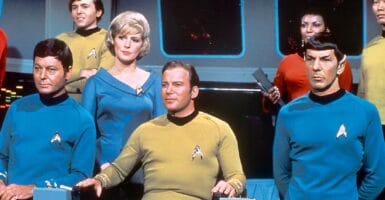NASA Animation Shows Ancient Mars As A Lush World
This article is more than 2 years old

Scientists know that Mars has changed a lot over the years. It used to be warm and wet, and quite possibly harbor at least microbial life, but now it’s cold, dry, and barren. On Monday, NASA launched the Mars MAVEN, which will spend about a year studying Mars’ atmosphere to gather data important in understanding how and why it has changed so drastically. One of the reasons we’re so captivated by the idea of ancient Mars is that it’s a lot easier to imagine humans living there.
And while we can’t turn back time, we do know that atmospheres can change, either via natural processes or, quite possibly, man-induced ones such as terraforming. In order to catalyze Mars dreams, whether they’re past, present, or future, and in order to get people engaged and excited about MAVEN’s mission, NASA created an animation of how scientists believe Mars may have looked about 4 billion years ago when it had a thick atmosphere.
While clearly the animation is linked to MAVEN, whose findings scientists await eagerly (it’ll be awhile — MAVEN won’t get to the Red Planet for about 10 months), I have to wonder whether NASA is gearing up for a Mars colonization campaign of its own. In his 2010 speech on space exploration, President Obama talked about manned missions to Mars around the year 2030 — long after he’s out of office, so there’s no way for him to prevent the next president from retracting that goal just as he did with the Bush Administration’s goal of putting a man back on the Moon. Mars colonization efforts will of course be pricey. Back in 1990 Congress entertained the idea of a Space Exploration Initiative that included a manned Mars mission, but that the plan hit a snag when Congress balked at the $450 billion estimate. That was the end of our plans to put a man on Mars, but according to Robert Zubrin, author of The Case for Mars: The Plan to Settle the Red Planet and Why We Must, as well as chairman of the Mars Society, says that it doesn’t have to be and shouldn’t be. In his book he says he could put people on the Red Planet for about $30 billion, largely because of new rocket technologies developed by companies such as SpaceX. He and other scientists argue that the mission makes the most sense as a one-way trip given the solar radiation problems and the cost of fuel.
So perhaps NASA is getting ready to make that push once again, especially given that, at the moment, private companies seem to be better positioned to lead the charge. But as Neil deGrasse Tyson argues,
maybe the government needs to lead the way and establish a business model before private companies jump into the fray, which is what has happened with travel and tourism to low-Earth orbit.
Or maybe, instead of a race to Mars, NASA will consider an ISS-style collaboration between countries and/or companies. Regardless of what happens, manned missions to Mars will happen — the colonization of the Red Planet is only a matter of time. And NASA’s probes, rovers, and videos only fuel that dream.












